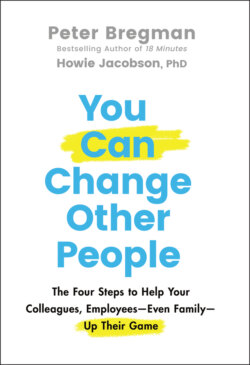Читать книгу You Can Change Other People - Howie Jacobson, Joel McDonald - Страница 12
PART TWO: THE FOUR STEPS
ОглавлениеThis is the practical “how-to” portion of the book. To illustrate the Four Steps, we'll follow one scenario all the way from the initial problem to a detailed plan of action. You'll listen in on the conversation at the beginning of each step. Then we'll debrief that step in the following chapters, exploring underlying principles, dos and don'ts, and exceptions.
Here's a brief description of each step:
Step 1: Shift from Critic to Ally (Chapters 7–13) This is the magic move. It gets you to the place where your conversation partner2 agrees to receive your help. You'll learn how to initiate conversations that help others change. Even better, you'll learn to recognize and capitalize on “silver platter” opportunities, times when people come to you already open to you helping them change—everyday opportunities that are easy to spot once you know what to look for. Start with this step and you'll move quickly past any potential resistance, well positioned as a trusted guide to help your partner change.
Step 2: Identify an Energizing Outcome (Chapters 14–17) This step shifts your partner from focusing on the problem to focusing on the outcome they want. It's a deceptively simple reorientation that moves people from frustration to excitement. For many years I didn't think this was such a big deal, but my clients tell me focusing on the desired outcome is not an obvious thing to do when they're mired in a difficult situation. It reliably gives them the right focus, exposing new and creative ways forward.
Step 3: Find the Hidden Opportunity (Chapters 18–22) In this step you return to the problem, but now you use it as an opportunity to achieve the outcome in a creative or unexpected way. Here's where you can help people change so that they not only get out of the mess they're in, but emerge at a whole new level of functioning.
Step 4: Create a Level-10 Plan (Chapters 23–27) In this final step you help your partner generate, refine, and commit to a specific action plan to achieve their energizing outcome. You're going for a “Level-10” plan, where they know exactly what they're going to do and are confident they can do it. This final step turns insight into action and intentions into impact.
Those are the Four Steps: Ally, Outcome, Opportunity, Plan. If you're into mnemonics, think of “Ally-OOP,” which, appropriately, sounds like the basketball pass that sets your teammate up for a slam dunk.
The companion website to this book (BregmanPartners.com/change) shares sample “partner dialogues” that demonstrate the Four Steps in different contexts. You'll find typical Four-Step conversations around hard issues that vary by domain (work and personal), power dynamic (supervisor/employee, spouses, parent/child, friends), and topic (work performance, health, relationship, personal goals). Before you have your first Four-Step conversation with a partner, read the sample dialogue that is most similar to the situation. It will help you find the right words to say and what kinds of responses you might expect from your partner.
***
Although I share important principles about personal change, especially in the first few chapters, this is not a conceptual book. You Can Change Other People is a user's manual, meant to be as practical as possible.
Don't wait until you've mastered the Four Steps to start using them to help people change. Transparency is part of this process. You should feel free to share exactly what you're doing and why you're doing it. Tell the truth: “Hey, I got this book and I think I can use the process to help you. I'm new at this, so it may not look smooth and polished. In fact, I might even pause and refer to the text from time to time. Are you open to that?”
Once you've read the book and practiced a few times, you will quickly grow your capability and confidence to use the Four Steps to help the people around you live fuller, richer, more powerful, and more authentic lives.
First, though, let's dispel the myth that people resist change.
